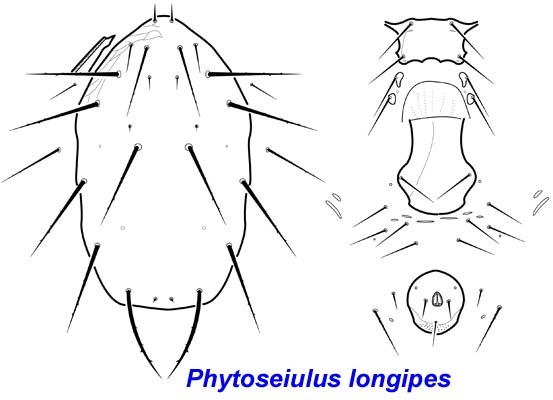Taxonomic Position
Cohort Gamasina
Subcorhort Dermanyssiae
Superfamily Phytoseioidea
Family Phytoseiidae Berlese
Phytoseiulus longipes Evans
Diagnostic characters of adult female:
-
Dorsal shield ca. 0.325-0.345 mm long
-
Dorsal shield setae j5 and S5 both absent; j6 long and barbed; R1 barbed and >2x r3
-
Peritrematal shield free from dorsal shield
-
Fixed digit of chelicera relatively short and with only 3 teeth
-
Calyx of spermatheca subtubular, tapering gradually from vesicle
-
Sternal shield with 2 pairs of setae; st3 and st4 both on small platelets
-
Anal opening on anal shield with 3 setae
-
Setae JV2 and JV4 in soft cuticle
-
Genu IV without macrosetae; macroseta on basitarsus IV simple (ca. 0.110 mm long)

Similar species. Other species of Phytoseiulus have a sternal shield with 3 pairs of setae (st1-2) and have dorsal shield setae j5 and S5.
Ecology & Distribution. Phytoseiulus longipes is the most morphologically aberrant member of the genus. It was described from southern Africa and is also known from southern South America.
References
Evans GO. 1958. A new mite of the genus Phytoseiulus Evans (Acarina: Phytoseiidae) from Southern Rhodesia. Journal of the Entomological Society of South Africa 21: 306-308.
Takahashi F & Chant DA. 1993. Phylogenetic relationships in the genus Phytoseiulus Evans (Acari: Phytoseiidae). II. Taxonomic Review. International Journal of Acarology 19: 23-37.